Natural Gas Furnaces
Overview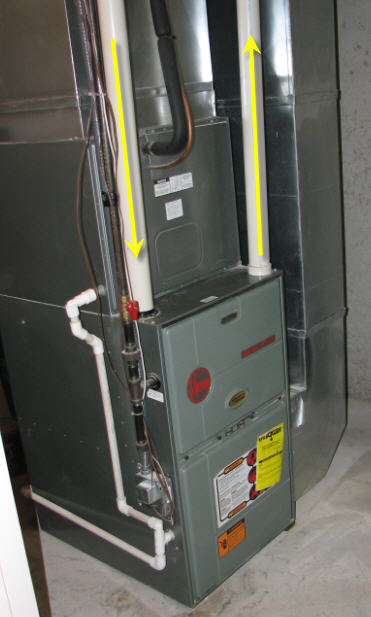
Where natural gas is easily available, the forced air furnace easily dominates the space heating market; the colder the climate, the higher the percentage of dominance.
Natural gas is the lowest cost fuel and the forced air furnace is the lowest cost central system. This remains true even with the recent increases in the price of natural gas, as fuel oil and propane have seen higher increases and more price volatility.
Great improvements in efficiency have been made over the last 20 years. Any furnace less than 80% efficient or more than 20 years old, is a candidate for replacement.
For any house that is at least modestly insulated, replacing a 20 year old furnace is likely to be the largest single energy management measure that can be taken to reduce heating costs.
Furnace Type and Efficiency
Efficiency has at least two ratings:
-
- a steady-state or combustion efficiency
- a AFUE, seasonal, standby, or cycle efficiency
The steady-state or combustion efficiency is based on how good the unit is at mixing air and gas in the burner, where the combustion air comes from and how efficient the heat exchanger is at getting the heat from the combustion process into the air being heated. The steady-state rating can be up to 20% higher than the seasonal rating.
The Annual Fuel Utilization Efficiency – AFUE, takes into consider the off-cycle losses. This rating is influenced by how the furnace is vented, if it has a standing pilot or IID and its cycling performance. The steady state efficiency can be measured, but the AFUE can only be estimated based on accepted factors applied to the steady state efficiency.
All furnaces built and sold in the US today must be at least 78% AFUE; to have an ENERGY STAR rating, they must be at least 90% AFUE.
Estimate typical ANNUAL Furnace Efficiency (AFUE):
- old, gravity, conversion furnace with standing pilot – 50%
- old, forced-air, standing pilot, 60%
- 20 – 40 years old, natural draft 65 – 70%
- less than 20 years old, forced vent through metal flue pipe 75 – 80%
- less than 20 years old, condensing (plastic flue pipe) 85 – 90%
- less than 10 years old, condensing, multi-speed fans, multi-stage burners, outside combustion air 90 – 97%
The above rankings clearly show the best way to reduce total heating costs is to replace an old heating system.
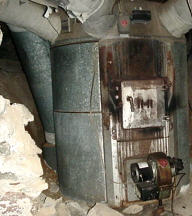 Old Gravity and Conversion Furnaces – they are sometimes referred to as ‘octopus’ or ‘elephant’ furnaces. This type of furnace was designed to burn coal or wood and later converted to natural gas. It may also have been converted to fuel oil before natural gas. It is very large, with a heavy fire pot and ductwork. Most do not have fans, although some may also have been retrofitted with a small fan. They are centrally located in a basement with a large return air duct in the middle of the house and several large heating ducts that radiate out to towards the outside walls of the house. They have a standing pilot that must be manually lit.
Old Gravity and Conversion Furnaces – they are sometimes referred to as ‘octopus’ or ‘elephant’ furnaces. This type of furnace was designed to burn coal or wood and later converted to natural gas. It may also have been converted to fuel oil before natural gas. It is very large, with a heavy fire pot and ductwork. Most do not have fans, although some may also have been retrofitted with a small fan. They are centrally located in a basement with a large return air duct in the middle of the house and several large heating ducts that radiate out to towards the outside walls of the house. They have a standing pilot that must be manually lit.
Older Forced-air Furnaces – that are 40 years or older typically have cast-iron (high mass) heat exchangers and simple cast iron burners. They do have a fan, smaller ductwork, and a standing pilot.
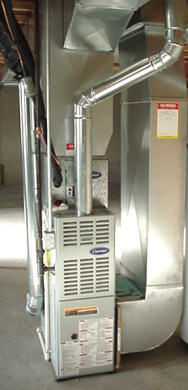 Natural Draft Forced Air Furnaces – the next generation of furnace has lighter weight heat exchangers, better burners and may have an automatic Intermittent Ignition Device (IID). They require a chimney or metal flue for natural draft combustion and venting.
Natural Draft Forced Air Furnaces – the next generation of furnace has lighter weight heat exchangers, better burners and may have an automatic Intermittent Ignition Device (IID). They require a chimney or metal flue for natural draft combustion and venting.
Forced Draft, Non-condensing Furnace – have a fan that forces the products of combustion out through a small metal flue and draw combustion air into the burner chamber. It may use inside or outside combustion air. Using outside combustion air adds at least 5% annual efficiency. It has an IID.
Any furnace with a metal flue pipe and open front that pulls combustion air from the inside, heated space, cannot be more than about 80% combustion efficiency, and is much lower seasonal efficiency due to all the heated air lost up the flue during off-cycles.
 Condensing Furnace – has a plastic flue pipe; a second heat exchanger removes so much heat from the combustion gases that the temperature drops below 212F. The condensation results in additional heat called the ‘latent heat of condensation’ and a lot of water that must be drained away. Condensing furnaces have IID and no standby vent losses.
Condensing Furnace – has a plastic flue pipe; a second heat exchanger removes so much heat from the combustion gases that the temperature drops below 212F. The condensation results in additional heat called the ‘latent heat of condensation’ and a lot of water that must be drained away. Condensing furnaces have IID and no standby vent losses.
Multi-Stage Condensing Furnaces – in addition to the above, have multi-stage burners and variable speed distribution air fans to more closely match the furnace output with the space load. There can be a small efficiency gain over fixed rate units, but the biggest advantage is improved space comfort from more even temperatures.
Operation
Conventional Furnace
- Thermostat calls for heat
- Safety Pilot confirms pilot is lit and opens main gas valve
- Gas burner ignites and starts to heat the heat exchanger
- The heat exchanger thermostat (fan limit control) reaches its upper set temperature and turns on the distribution (ductwork) fan
- The burner continues to fire and the fan continues to run until the thermostat is satisfied
- The thermostat reaches its set point and sends a signal to close the main gas valve, turning off the burner
- The fan continues to run until the heat exchanger thermostat (fan limit control) reaches its lower set point and turns off the fan
Forced Draft and Condensing Furnace
Same steps as above with the addition of:
- draft control pressure switch proves the combustion fan is running before allowing the main gas value to open
Note: The Fan Limit Control is also a safety; if the heat exchanger gets too hot, the Control shuts off the gas burner. This could happen with a failed distribution fan or plugged ductwork.
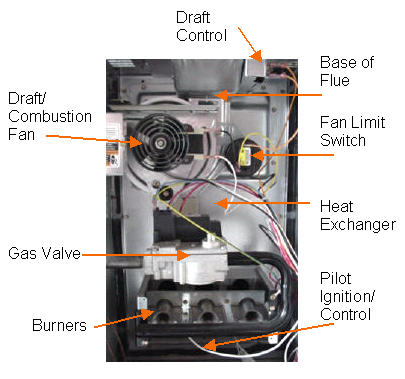
Retrofit Options
There were two retrofit options that were popular in the 1980’s and 1990’s that improved the efficiency of existing furnaces. An automatic Vent Damper and Intermittent Ignition Device (IID).
An automatic Vent Damper closes the flue during furnace off times. This reduces the off-cycle flue losses of heated air up the chimney. This can improve the effective annual efficiency by 5 – 10%. For more information see Vent Dampers.
An Intermittent Ignition Device can be added to most furnaces that have a standing pilot. However, they proved to be mostly uneconomical and a maintenance problem. This is because the gas they saved was very small compared to the first cost of the equipment with installation, and they had a high failure rate. IID units installed as factory original equipment are highly reliable and are required by Federal law.
Although vent dampers and IIDs are still available, a furnace old enough to benefit from one should be considered for replacement. New furnaces, even the non-condensing units, have smaller flues, forced draft, and no open ‘draft hoods’, which means they loose less up the flue. Also, a vent damper could interfere with proper forced draft operation so it should not be installed on many newer furnaces.
Vent dampers are more common on boilers, which tend to last longer and have much higher replacement costs.
Furnace Sizing
It is important for comfort and efficiency that a furnace be correctly sized for the space. Traditional practice has been to over-size a furnace and use about a 100,000 BTU furnace for any ‘average’ house, and maybe 200,000 BTUs for a large house.
Furnaces are the least efficient when they are warming up, and cooling down. Therefore, a furnace that is over-sized goes through more cycles and has a lower over-all efficiency. This cycling also produces more uneven temperatures in the space, reducing comfort.
The best way to size a furnace is with an accurate Heat Loss calculation of the house.
Manufacturers
Notice: According to one directory, there are over 185 brand names of residential furnaces; this listing in no way is intended to be all inclusive or endorsing. It is only provided as a convenience to find several major brands that are available in most of the US and Canada.

Go to the Amana web site at www.amana-hac.com
![]()
Go to the American Standard web site at www.americanstandard-air.com
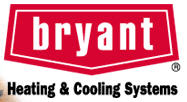
Go to the Bryant web site at www.bryant.com

Go to the Carrier web site at www.carrier.com/residential/en/us/

Go to the Coleman web site at www.colemanac.com

Go to the Heil web site at www.heil-hvac.com

Go to the Lennox web site at www.davelennox.com

Go to the Trane web site atwww.trane.com/Residential/NewSystem/Guides/GasFurnaces.asp

Go to the Rheem web site at www.rheemac.com

Go to the Ruud web site at www.ruudac.com
Organizations and Directories

The Gas Appliance Manufacturers Association (GAMA) is a national trade association whose members manufacture over 90 percent of all the residential, commercial and industrial gas appliances made in the United States. GAMA also represents manufacturers of certain products which use oil or electricity as their energy source.
The GAMA web site includes a membership directory with links to most US Manufacturer’s web sites.
Go to the GAMA web site www.gamanet.org
Source: Text Bob Fegan 12/2008; photos Bob Fegan; logos of corporations listed and linked above;
© 2008 Energy Solutions Center400 N. Capitol Street NWWashington, DC 20001 All rights reserved. Legal Contact our webmaster
